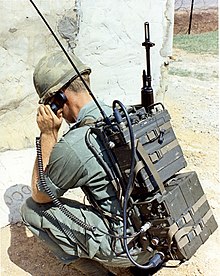




NESTOR was a family of compatible, tactical, wideband secure voice systems developed by the U.S. National Security Agency and widely deployed during the Vietnam War through the late Cold War period of the 1980s. NESTOR consists of three systems. The KY-8 was used in vehicular and afloat applications; the KY-28 was the airborne version; and the KY-38 was the portable or man-pack model. About 30,000 NESTOR equipments were produced prior to their replacement by the VINSON secure voice family.[1]: Vol I, p.79
Keying was accomplished by setting each switch in a matrix of switches to one of several positions. This was done using a separate mechanical key loader (KYK-28) that had a matching matrix of pins that could be set to different heights as instructed by a key list. The key loader was pushed into a matrix of holes, one hole for each switch. The loader also had two larger index pins that also cocked a spring that would return each switch to its initial position when the door covering the hole matrix was reopened, zeroizing the equipment.[2][3]
- ^ A History of U.S. Communications Security; the David G. Boak Lectures, National Security Agency (NSA), Volumes I, 1973, Volumes II 1981, partially released 2008, additional portions declassified October 14, 2015
- ^ "KY-38 Voice Security Unit". www.prc68.com.
- ^ "KY28 Cryptosystem". www.jproc.ca.